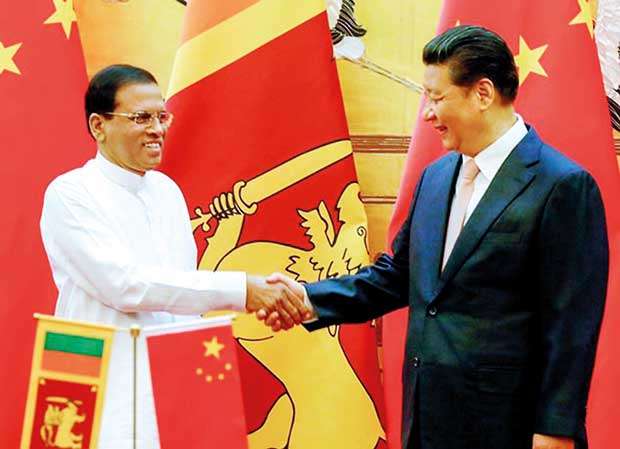22 May 2018 - {{hitsCtrl.values.hits}}

 It was good news for the country on Monday when China approved a US $ 1 billion loan to revive a long-delayed expressway in central Sri Lanka. The construction of the first phase of the road linking the capital Colombo with the hill resort of Kandy had been delayed for more than two years due to a lack of foreign funding.
It was good news for the country on Monday when China approved a US $ 1 billion loan to revive a long-delayed expressway in central Sri Lanka. The construction of the first phase of the road linking the capital Colombo with the hill resort of Kandy had been delayed for more than two years due to a lack of foreign funding.
Prime Minister Ranil Wickremesinghe met the Chinese ambassador on Monday. The ambassador had informed the prime minister that Beijing had decided to approve the loan that will be provided through the Export-Import Bank of China, which can be considered as part of its regional Belt and Road Initiative.
When the ambitious Belt and Road Initiative – with projects reportedly worth US $ 1 trillion – was first announced by President Xi Jinping in the autumn of 2013, many were sceptical of this Chinese move aimed at building up economic connectivity of 65 nations (China plus 64) along its ancient Silk Road and maritime routes.
For China, this New Silk Road would also serve to redirect the country’s domestic overcapacity and capital for regional infrastructure development to improve trade and ties with Asian, South Asian and European countries.
Unprecedented in terms of China’s financial commitment, many critics have viewed this strategy as a foreign policy strategy designed to expand Beijing’s influence to poor nations hungry for economic and infrastructure development.
However, for Sri Lanka, this New Silk Road would also serve to further strengthen trade, political and economic ties. This is undoubtedly a boon for debt-ridden countries, which look to China, given the versatility of China’s approach in engaging Asian countries.
China’s liberality in providing funding for massive projects is partly responsible for China’s surge as one of the major economic influences on the continent. For example, Sri Lanka’s debt maturities between 2019 and 2022 total US $ 13.9 billion. Despite the port agreement bolstering reserves, the foreign reserves challenges are expected to remain and the rupee continues to be under pressure.
Many analysts say that the latest news is credit positive for Sri Lanka because it will boost foreign exchange reserves, which will ease the country’s external liquidity position ahead of several large international bond payments between 2019 and 2022.
The government needs more foreign direct investment (FDI) to feed into the Central Bank’s foreign exchange reserves, which will help bolster investor confidence and encourage the future portfolio inflows. Importantly, it will allow the government to set aside earnings to repay its upcoming debt maturities and reduce its external debt, a key constraint on Sri Lanka’s credit quality.
Foreign debt
External debt maturities between 2019 and 2022 total US $ 13.9 billion. Sri Lanka’s balance of payments position remains vulnerable after foreign currency reserves materially declined in late 2016 and early 2017. More recently, the reserves have risen somewhat because of capital inflows from the international sovereign bond issuance and FDI.
As of May, the gross official foreign-exchange reserves (including gold and special drawing rights) were US $ 9.9 billion. The foreign currency reserves portion of gross reserves was slightly under US $ 8 billion, covering about five months of imports, above the International Monetary Fund’s (IMF) minimum reserves adequacy threshold of three months.
The Central Bank of Sri Lanka intends to increase the gross official reserve assets to at least US $ 11 billion by mid-June, in accordance with the targets under Sri Lanka’s current three-year IMF Extended Fund Facility programme.
The market expects the Central Bank to come close to its target, which would help support the country’s credit quality. Moving forward, greater exchange-rate flexibility and more limited foreign-exchange interventions by the Central Bank would help preserve the reserves.
Although the Hambantota receipts from the major Chinese investment there will ease the external pressures, the foreign exchange challenges will continue to remain, given the persistent elevated government debt and large borrowing requirements.
Furthermore, Sri Lanka’s external vulnerability indicator, which measures the ratio of external debt payments that are due over the next year to foreign-exchange reserves, to rise further. Development of the broader Hambantota port area and the industrial zone will help to bring in FDI of around US $ 585 million in June from China to ease the pressure. A further US $ 1.1 billion is due by way of syndicated loans and US $ 250 from an IMF tranche.
Importance of China
The Sri Lankan political leaders often give lip service to the country’s geopolitical importance. Sri Lanka sits at the heart of the Indian Ocean, adjacent to major shipping routes, within the world’s most promising regions—the Indo-Pacific, long described as the ‘pearl of the Indian Ocean.
However, we have failed to take the maximum advantage of this strategic geographical positioning. The Chinese-build Port City is one major initiative that has had bipartisan political support. Conceived during the Rajapaksa period, it has been taken to new heights by the Sirisena-Wickremesinghe government.
The build-up of associated infrastructure surrounding the port also can help to attract greater private sector investments. If the country is led well, this together with other ongoing development projects, such as the Western Region Megapolis Plan and Colombo Financial City Project, will provide a stable source of financing for Sri Lanka’s external position and support economic growth.
The balance money from the port deal and the free trade zones and also the proposed arrangement with India for the Mattala airport, will allow the government to focus on the key priorities, including advancing economic and structural reforms under its IMF programme that would help the island economy to focus on an export-driven growth model led by private investment.
The construction of the Port City is set to generate tens of thousands of jobs and the foreign finance it attracts is seen as crucial to reducing the country’s US $ 64.9 billion debt burden. Last December, Sri Lanka leased out the Hambantota port to China; also leaseholds an adjacent land to the port.
A joint venture between state-controlled China Merchants Port Holdings and the Sri Lanka Ports Authority, the deal, in which the Chinese partner holds a 70 percent stake, was criticised for undermining Sri Lankan sovereignty. For the government winning the argument is not only central to the success of big development projects in the country and attracting Chinese investment. The government certainly needs to work on the relationship much more than what it is doing now if they are to really benefit from the Silk Road initiatives.
(Dinesh Weerakkody is a thought leader)
18 Nov 2024 2 hours ago
18 Nov 2024 3 hours ago
18 Nov 2024 3 hours ago
18 Nov 2024 3 hours ago
18 Nov 2024 3 hours ago